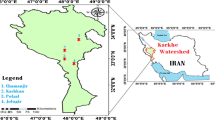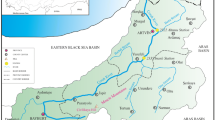Abstract
River flow modeling is essential for critical aspects such as effective water management and structure planning, together with flood and drought analysis. There has been a growing interest in modeling hydrological systems via machine learning (ML) models. Various optimization techniques are utilized to develop the applications of ML-based hydrological models. The ultimate aim of this research is to establish high performance forecasting model. Therefore, this study conducts river flow modeling by using the daily data attained from a gauge station situated in the Euphrates Basin. For this purpose, Artificial Neural Network (ANN) model was hybridized with five different optimization algorithms i.e., Artificial Bee Colony (ABC), Teaching-Learning Based Optimization (TLBO), Ant Colony Optimization (ACO), Ant-Lion Optimization (ALO), and Imperialist Competitive Algorithm (ICA). In determining the inputs used to create the models, the distribution graph and correlation of the data with the previous period data were examined. The results were evaluated with eleven different statistical parameters and an error matrix. Examining the obtained results, the study revealed all models present high performance. When the results were reviewed in general, it was seen that all determination coefficient (R2) and Nash-Sutcliffe coefficient (NSE) values were higher than 0.962, and other parameters were very close to the optimum. By comparing all the developed hybrid models, ANN-ALO model reported the highest performance for river flow forecasting.








Similar content being viewed by others
Data Availability
The daily river flow data used in the study can be accessed through the Republic of Turkey State Hydraulic Works Flow Observation Annuals. Annuals are available online at https://www.dsi.gov.tr/Sayfa/Detay/744.Reviewer
References
Abdollahi S, Raeisi J, Khalilianpour M, Ahmadi F, Kisi O (2017) Daily mean streamflow prediction in perennial and non-perennial rivers using four data driven techniques. Water Resour Manag 31(15):4855–4874. https://doi.org/10.1007/s11269-017-1782-7
Abeysingha NS, Singh M, Sehgal VK, Khanna M, Pathak H, Jayakody P, Srinivasan R (2015) Assessment of water yield and evapotranspiration over 1985 to 2010 in the Gomti River basin in India using the SWAT model. Curr Sci:2202–2212
Adamowski J, Sun K (2010) Development of a coupled wavelet transform and neural network method for flow forecasting of non-perennial rivers in semi-arid watersheds. J Hydrol 390(1–2):85–91. https://doi.org/10.1016/j.jhydrol.2010.06.033
Ahmadi MA, Ebadi M, Shokrollahi A, Majidi SMJ (2013) Evolving artificial neural network and imperialist competitive algorithm for prediction oil flow rate of the reservoir. Appl Soft Comput 13(2):1085–1098. https://doi.org/10.1016/j.asoc.2012.10.009
Assiri AS, Hussien AG, Amin M (2020) Ant lion optimization: variants, hybrids, and applications. IEEE Access 8:77746–77764. https://doi.org/10.1109/ACCESS.2020.2990338
Banadkooki FB, Ehteram M, Ahmed AN, Teo FY, Ebrahimi M, Fai CM et al (2020) Suspended sediment load prediction using artificial neural network and ant lion optimization algorithm. Environ Sci Pollut Res 27(30):38094–38116. https://doi.org/10.1007/s11356-020-09876-w
Behera RR, Ghadai RK, Kalita K et al (2016) Simultaneous prediction of delamination and surface roughness in drilling GFRP composite using ANN. Int J Plast Technol 20:424–450. https://doi.org/10.1007/s12588-016-9163-2
Chen W, Chen X, Peng J, Panahi M, Lee S (2021) Landslide susceptibility modeling based on ANFIS with teaching-learning-based optimization and satin bowerbird optimizer. Geosci Front 12(1):93–107. https://doi.org/10.1016/j.gsf.2020.07.012
Chen W, Panahi M, Khosravi K, Pourghasemi HR, Rezaie F, Parvinnezhad D (2019) Spatial prediction of groundwater potentiality using ANFIS ensembled with teaching-learning-based and biogeography-based optimization. J Hydrol 572:435–448. https://doi.org/10.1016/j.jhydrol.2019.03.013
Chen XY, Chau KW, Busari AO (2015) A comparative study of population-based optimization algorithms for downstream river flow forecasting by a hybrid neural network model. Eng Appl Artif Intell 46:258–268. https://doi.org/10.1016/j.engappai.2015.09.010
Chok NS (2010) Pearson's versus Spearman's and Kendall's correlation coefficients for continuous data (Doctoral dissertation, University of Pittsburgh). https://doi.org/10.4236/ce.2018.911125
Christner TE (2020) Unequal funding: subsidization prediction in university athletics (order no. 27999143). Available from ProQuest Dissertations & Theses Global. (2419116702).
Dehghani R, Poudeh HT (2021) Applying hybrid artificial algorithms to the estimation of river flow: a case study of Karkheh catchment area. Arab J Geosci 14(9):1–19. https://doi.org/10.1007/s12517-021-07079-2
Dey K, Kalita K, Chakraborty S (2022) Prediction performance analysis of neural network models for an electrical discharge turning process. Int J Interact Des Manuf. https://doi.org/10.1007/s12008-022-01003-y
Diyaley S, Chakraborty S (2021) Teaching-learning-based optimization of ring and rotor spinning processes. Soft Comput 25(15):10287–10307. https://doi.org/10.1007/s00500-021-05990-0
Diyaley S, Chakraborty S (2022) Metaheuristics-based nesting of parts in sheet metal cutting operation. Oper Res Eng Sci: Theory Appl https://doi.org/10.31181/oresta180222031d
Diyaley S, Aditya A, Chakraborty S (2020) Optimization of the multi-hole drilling path sequence for concentric circular patterns. Opsearch 57(3):746–764. https://doi.org/10.1007/s12597-020-00441-0
Dorigo M (1992) Optimization, learning and natural algorithms (in Italian). Ph. D. thesis, Dipartimento di Elettronica, Politecnico di Milano, Italy
Dorigo M, Di Caro G, Gambardella LM (1999) Ant algorithms for discrete optimization. Artificial Life 5(2):137–172. https://doi.org/10.1162/106454699568728
Farfán JF, Cea L (2021) Coupling artificial neural networks with the artificial bee colony algorithm for global calibration of hydrological models. Neural Comput & Applic 33(14):8479–8494. https://doi.org/10.1007/s00521-020-05601-3
Fattahi H, Hasanipanah M (2021) An indirect measurement of rock tensile strength through optimized 466 relevance vector regression models, a case study. Environ. Earth Sci 80(22):1–12. 467. https://doi.org/10.1007/s12665-021-10049-2468
Gargari AE, Lucas C (2007) Imperialist competitive algorithm: an algorithm for optimization inspired by 469 imperialistic competition. In 2007 IEEE congress on evolutionary computation (pp. 4661-4667). Ieee. 470 https://doi.org/10.1109/CEC.2007.4425083.471
Gupta HV, Sorooshian S, Yapo PO (1999) Status of automatic calibration for hydrologic models: comparison with multilevel expert calibration. J Hydrol Eng 4(2):135–143. https://doi.org/10.1061/(ASCE)1084-0699(1999)4:2(135)
Hasanipanah M, Bakhshandeh Amnieh H (2020) A fuzzy rule-based approach to address uncertainty in risk 472 assessment and prediction of blast-induced Flyrock in a quarry. Nat Resour Res 29(2):669–689. 473. https://doi.org/10.1007/s11053-020-09616-4474
Hasanipanah M, Bakhshandeh Amnieh H (2021) Developing a new uncertain rule-based fuzzy approach for 475 evaluating the blast-induced backbreak. Eng Comput 37(3):1879–1893. https://doi.org/10.1007/s00366-019-00919-6477
Hasanipanah M, Meng D, Keshtegar B, Trung NT, Thai DK (2021) Nonlinear models based on enhanced 478 kriging interpolation for prediction of rock joint shear strength. Neural Comput & Applic 33(9):4205–479 4215. https://doi.org/10.1007/s00521-020-05252-4480
Hasanipanah M, Monjezi M, Shahnazar A, Armaghani DJ, Farazmand A (2015) Feasibility of indirect 481 determination of blast induced ground vibration based on support vector machine. Measurement 75(289–297):482. https://doi.org/10.1016/j.measurement.2015.07.019483
Hassanvand MR, Karami H, Mousavi SF (2018) Investigation of neural network and fuzzy inference neural 484 network and their optimization using meta-algorithms in river flood routing. Nat Hazards 94(3):1057–1080. https://doi.org/10.1007/s11069-018-3456-z
Humphrey GB, Gibbs MS, Dandy GC, Maier HR (2016) A hybrid approach to monthly streamflow forecasting: integrating hydrological model outputs into a Bayesian artificial neural network. J Hydrol 540:623–640. https://doi.org/10.1016/j.jhydrol.2016.06.026
Ibrahim KSMH, Huang YF, Ahmed AN, Koo CH, El-Shafie A (2022) A review of the hybrid artificial intelligence and optimization modelling of hydrological streamflow forecasting. Alex Eng J 61(1):279–303. https://doi.org/10.1016/j.aej.2021.04.100
Joshi M, Ghadai RK, Madhu S, Kalita K, Gao XZ (2021) Comparison of NSGA-II, MOALO and MODA for multi-objective optimization of Micro-machining processes. Materials 14(17):5109. https://doi.org/10.3390/ma14175109
Karaboga D (2005) An idea based on honey bee swarm for numerical optimization (Vol. 200, pp. 1–10). Technical report-tr06, Erciyes university, engineering faculty, computer engineering department.
Karaboga D, Basturk B (2007) Artificial Bee Colony (ABC) optimization algorithm for solving constrained optimization problems. Lecture Notes Comput Sci (Including Subseries Lecture Notes in Artificial Intelligence and Lecture Notes in Bioinformatics), 4529 LNAI (December), 789–798. https://doi.org/10.1007/978-3-540-72950-1_77.
Kisi O, Alizamir M, Zounemat-Kermani M (2017) Modeling groundwater fluctuations by three different evolutionary neural network techniques using hydroclimatic data. Nat Hazards 87(1):367–381. https://doi.org/10.1007/s11069-017-2767-9
Kisi O, Ozkan C, Akay B (2012) Modeling discharge–sediment relationship using neural networks with artificial bee colony algorithm. J Hydrol 428:94–103. https://doi.org/10.1016/j.jhydrol.2012.01.026
Kumar V, Diyaley S, Chakraborty S (2020) Teaching-learning-based parametric optimization of an electrical discharge machining process. Facta Universitatis. Series. Mech Eng 18(2):281–300. https://doi.org/10.22190/FUME200218028K
Kutner MH, Nachtscheim CJ, Neter J, Li W (2005) Applied linear statistical models, 5th edn. McGraw-Hill/Irwin, New York, NY
Li X, Sha J, Li YM, Wang ZL (2018) Comparison of hybrid models for daily streamflow prediction in a forested basin. J Hydroinf 20(1):191–205. https://doi.org/10.2166/hydro.2017.189
Mirjalili S (2015) The ant lion optimizer. Adv Eng Softw 83:80–98. https://doi.org/10.1016/j.advengsoft.2015.01.010
Panahi F, Ahmed AN, Singh VP, Ehtearm M, Haghighi AT (2021) Predicting freshwater production in seawater greenhouses using hybrid artificial neural network models. J Clean Prod 329:129721. https://doi.org/10.1016/j.jclepro.2021.129721
Pradeep T, Bardhan A, Burman A, Samui P (2021) Rock strain prediction using deep neural network and hybrid models of ANFIS and Meta-heuristic optimization algorithms. Infrastructures 6(9):129. https://doi.org/10.3390/infrastructures6090129
Rajendran S, Čep R, Pal S, Kalita K (2022) A conceptual comparison of six nature-inspired metaheuristic algorithms in process optimization. Processes 10(2):197. https://doi.org/10.3390/pr10020197
Rao RV, Savsani VJ, Vakharia DP (2011) Teaching–learning-based optimization: a novel method for constrained mechanical design optimization problems. Comput Aided Des 43(3):303–315. https://doi.org/10.1016/j.cad.2010.12.015
Rezaabad ZM, Ghazanfari S, Salajegheh M (2020) ANFIS modeling with ICA, BBO, TLBO, and IWO optimization algorithms and sensitivity analysis for predicting daily reference evapotranspiration. J Hydrol Eng 25(8):04020038. https://doi.org/10.1061/(ASCE)HE.1943-5584.0001963
Rezaie-Balf M, Fani Nowbandegani S, Samadi SZ, Fallah H, Alaghmand S (2019) An ensemble decomposition-based artificial intelligence approach for daily streamflow prediction. Water 11(4):709. https://doi.org/10.3390/w11040709
Tikhamarine Y, Malik A, Kumar A, Souag-Gamane D, Kisi O (2019) Estimation of monthly reference evapotranspiration using novel hybrid machine learning approaches. Hydrol Sci J 64(15):1824–1842. https://doi.org/10.1080/02626667.2019.1678750
Tikhamarine Y, Malik A, Pandey K, Sammen SS, Souag-Gamane D, Heddam S, Kisi O (2020) Monthly evapotranspiration estimation using optimal climatic parameters: efficacy of hybrid support vector regression integrated with whale optimization algorithm. Environ Monit Assess, 192(11): 1–19. https://doi.org/10.1007/s10661-020-08659-7
Toğan V (2012) Design of planar steel frames using teaching–learning based optimization. Eng Struct 34:225–232. https://doi.org/10.1016/j.engstruct.2011.08.035
Uysal G, Sensoy A, Sorman AA (2016) Improving daily streamflow forecasts in mountainous upper Euphrates basin by multi-layer perceptron model with satellite snow products. J Hydrol 543:630–650. https://doi.org/10.1016/j.jhydrol.2016.10.037
Uzlu E, Kankal M, Akpınar A, Dede T (2014) Estimates of energy consumption in Turkey using neural networks with the teaching–learning-based optimization algorithm. Energy 75:295–303. https://doi.org/10.1016/j.energy.2014.07.0783
Veaux RDD, Ungar LH (1994) Multicollinearity: a tale of two nonparametric regressions. In: Selecting models from data. Springer, New York, NY, pp 393–402
Wang W, Van Gelder PH, Vrijling JK, Ma J (2006) Forecasting daily streamflow using hybrid ANN models. J Hydrol 324(1–4):383–399. https://doi.org/10.1016/j.jhydrol.2005.09.032
Washington S, Karlaftis M, Mannering F, Anastasopoulos P (2020) Statistical and econometric methods for transportation data analysis. Chapman and Hall/CRC. https://doi.org/10.1201/9780429244018
Yilmaz AG, Imteaz MA, Jenkins G (2011) Catchment flow estimation using artificial neural networks in the mountainous Euphrates Basin. J Hydrol 410(1–2):134–140. https://doi.org/10.1016/j.jhydrol.2011.09.031
Yuan X, Chen C, Lei X et al (2018) Monthly runoff forecasting based on LSTM–ALO model. Stoch Environ Res Risk Assess 32:2199–2212. https://doi.org/10.1007/s00477-018-1560-y
Zhang W, Phoon KK (2022) Editorial for advances and applications of deep learning and soft computing in 545 geotechnical underground engineering. J Rock Mech Geotech Eng 546. https://doi.org/10.1016/j.jrmge.2022.01.001547
Zheng G, Zhang W, Zhang W, Zhou H, Yang P (2021) Neural network and support vector machine models 548 for the prediction of the liquefaction-induced uplift displacement of tunnels. Underground Space 6(2):126–133. 549. https://doi.org/10.1016/j.undsp.2019.12.002
Funding
The authors declare that no funds, grants, or other support were received during the preparation of this manuscript.
Author information
Authors and Affiliations
Contributions
All authors contributed to the study conception and design. Material preparation, data collection and analysis were performed by [Pijush Samui], [Zaher Mundher Yaseen], [Sanjiban Sekhar Roy] and [Sanjay Kumar]. The first draft of the manuscript was written by [Sefa Nur Yesilyurt] and [Huseyin Yildirim Dalkilic]. All authors read and approved the final manuscript.
Corresponding author
Ethics declarations
Competing Interests
The authors have no relevant financial or non-financial interests to disclose.
Additional information
Communicated by: H. Babaie
Publisher’s note
Springer Nature remains neutral with regard to jurisdictional claims in published maps and institutional affiliations.
Rights and permissions
Springer Nature or its licensor (e.g. a society or other partner) holds exclusive rights to this article under a publishing agreement with the author(s) or other rightsholder(s); author self-archiving of the accepted manuscript version of this article is solely governed by the terms of such publishing agreement and applicable law.
About this article
Cite this article
Samui, P., Yesilyurt, S.N., Dalkilic, H.Y. et al. Comparison of different optimized machine learning algorithms for daily river flow forecasting. Earth Sci Inform 16, 533–548 (2023). https://doi.org/10.1007/s12145-022-00896-3
Received:
Accepted:
Published:
Issue Date:
DOI: https://doi.org/10.1007/s12145-022-00896-3




